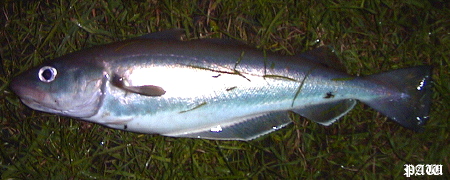Identification:
Belongs to the Cod family, but has a more slender build than either Cod or
Haddock.
The body has three dorsal and two anal fins.
First anal fin starts vertically beneath the centre of the first dorsal fin,
and finishes level with the end of the second dorsal fin.
The pectoral fin has a small but distinct black spot at it's base.
The body colouration is divided, with the upper part often taking a golden
olive green hue, and the sides and belly, a silvery sheen with a very pale
bluish white. Lateral line tends to divide the colouration, and is itself
a pale brown.
The upper jaw is longer than the lower, and normally lacks a barbel on the
chin (except for very young fish (<5mm in length), in which it is very
small.). The mouth tends to be large in relation to head size.
Breeding:
Spawning normally occurs March to April in 100m of water.
Fry are 3.4mm in size, and show adult characteristics by the time they reach
25mm in length.
Small whiting (30mm) are often found in close association with jellyfish
of the upper water column... it is thought that this may afford protection
to the small fish, whilst aiding their abilities to ambush potential prey.
Growth is fairly rapid with 17cm in the first year, and 25cm in their second.
Maturity is also reached in their second spring...
May live between 5-8years
Habitat:
Whiting tend to be mid to bottom water feeders in depths of 20 to 150m (although
juveniles often in shallower water), found in shoals often over sand or sandy
mud / gravel.
Food:
Plankton and crustacean larvae when very young, moving onto krill and shrimp....
this extends to prawn, crab, amphipods, gobies, and sandeels as they get
bigger. Large whiting have a wider diet to include small herring, sprats,
sandeels, and small whiting.
Range:
English Channel, North Sea, Irish Sea
Additional Notes:
Good to Fair eating...... flesh easily tainted, and should be gutted straight
away to maintain it's delicate flavour. |

